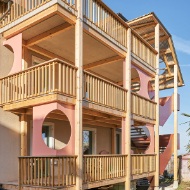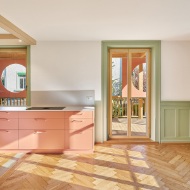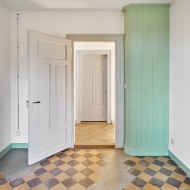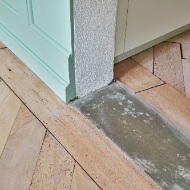‘Instead of demolishing and starting again from scratch, we build on what is already there.’

So goes one of the principles of Baubüro in situ, who designed the sustainable conversion of an apartment building in Rorschach dating back to 1914. Blumer Lehmann carried out this sustainable conversion as joint general contractor in constructive collaboration with all parties involved in the build. The unusual and ambitious element here was that existing, overlaid, or now unused materials and features were harnessed to create new accents.
Meret Hodel, an architect at Baubüro in situ who was involved in the conversion of this apartment building in Rorschach, tells us about its resource-conserving design.
Meret Hodel, what conditions need to be met for a conversion where materials and components are reused?
MERET HODEL It’s important that the client and other parties to the project are motivated and ready to get involved in the process. In this project, it was lucky that the clients actively approached us and were excited about getting involved in the planning process. Everyone needs to be open to ideas and look for solutions together. Additionally, it helps when a building dates back to a construction period that used high-quality materials and features.
How important are materials for conversion projects?
Materials are the substance we work with and hence dictate what we are able to do. The material has to serve in some way – it needs to be resilient, so it can be changed and transformed. High-quality, pure materials can be revived and composed. And of course even better if they are mechanically fixed rather than glued or concreted in. For any structural elements that we need to produce afresh and can’t create from existing material, we use biobased materials such as timber. It regrows, is straightforward to process, and is – where needed – easy to dismantle later.
How is a reuse conversion planned and implemented?
We prioritise the process. This includes how we handle the existing building, the place, the people, and the suggestions they bring to us. The way we approach it is to first try to grasp the potential of a building and identify its qualities. For the Rorschach conversion, we wanted to retain the varied floor plan situation. We then move from overall qualities into the details and continue to define what can be accentuated and augmented. This might be well-preserved windows or attractive parquet flooring. We look at what is there like it’s a construction kit and decide what we will reuse where.
With the conversion of this building in Rorschach, why were materials reused, and how important was this aspect to the conversion project?
New replacement building or converting? This was what the clients asked us. We suggested a conversion. This is because when you work with the existing structure, you save a lot of grey energy (energy from polluting sources) and you always end up with a better energy footprint than with a new build. Even when the old building is poorly insulated and a new build meets Minergie standards (quality label for low-energy-consumption buildings). The clients in Rorschach were open to a conversion with reuse, and engaged with the conversion. They also appreciated the stories that arose through the materials that were reused. Like how you enter the house over what used to be the stair treads but now serve as a threshold.
«When you work with the existing structure, you save a lot of grey energy and you always end up with a better energy footprint than with a new build.»Meret Hodel
About the person
Meret Hodel, architect EPFL/ETH | VR, deepened her interest in new forms of living together in the course of the "case study steel house" project after completing her Master's degree at ETH. She became involved in the Pavilleon association, an interim use of the Werdmühleplatz cultural pavilion, and in Next Zürich, an association for participatory urban development. Hodel has been working at the in situ construction office since 2017.

The recycled apartment building with new wooden stair tower and arcades.
To the timber construction reference
Is it worth it, financially and in terms of effort, to reuse materials and components?
There’s a comparison we like to use: building with reuse is a bit like bioproducts. It shows that we can build with reused and recycled materials and it represents a sustainable approach to construction. It is, however, not cheaper. To achieve this, we need to further define the processes and grow our network with professional tradespeople and businesses to help things flow more seamlessly. However, sustainability is something people are tackling in all areas nowadays. And in construction, the leverage effect of this is enormous. Building contractors and investors are well aware of this. Added to this is that many people no longer want to live and work in bog standard buildings. Instead they want unique buildings that have a story to tell.
What were the challenges in the Rorschach project?
The cap on cost was set from the start and created a fixed framework. And then there were a few surprises, as there are for every conversion: an example being the unstable masonry in the cellar. For this and for other tricky areas, we needed to work together to find affordable solutions. Ultimately the conversion was a success and the clients are very happy. Nevertheless, in process-driven architecture it’s important to meticulously define the interfaces between client, planner and contractor and to organise these clearly in the planning and construction process.










